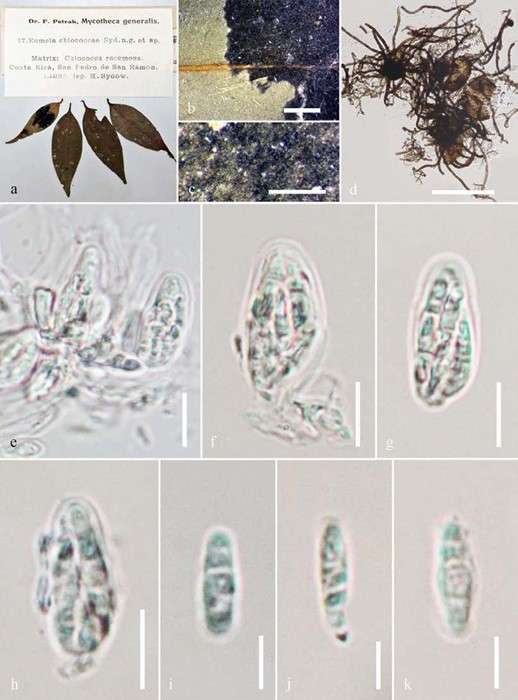Eumela chiococcae Syd., Annls mycol. 23(3/6): 335 (1925) Fig. 4
MycoBank number: MB 260515; Index Fungorum number: IF 260515; Facesoffungi number: FoF 06241;
Parasitic on living leaves of Chiococca racemosa, colonies large, superficial, irregular, black, with superficial mycelium forming a network, hypophyllous, dark brown outwardly. Sexual morph: Ascomata 50–85 μm high × 73–75 μm diam, sessile, small, superficial, solitary, scattered, globose to subglobose, black, papillate, surrounded by brown to dark brown, undulate hyphae, longer than 100 μm, branched, septate. Peridium comprising brown cells of textura angularis to subglobosa, lacking pseudoparaphyses. Hairy peridial hyphae longer than 100 μm, pale brown to dark brown, simple, unbranched, numerous, straight or curved, septate, gradually paler upwards, flexuous, slightly constricted at the septa, apex rounded. Asci 12–17 μm × 7–8 μm ( x = 15.7 × 8.0 μm, n = 10), 8-spored, bitunicate, broadly clavate, cylindrical to nearly ellipsoidal, sessile, slightly thickened and bluntly rounded near the apex. Ascospores 10.0–10.5 μm × 2.5–3.0 μm ( x = 10.3 × 2.8 μm, n = 10), multi-seriate, overlapping, oblong to ovoid oblong, ends rounded, 1-septate, slightly constricted at the septum, hyaline, smooth-walled. Asexual morph: Undetermined.
Material examined – COSTA RICA, Alajuela, Grecia, on living leaves of Chiococca racemosa L., (Rubiaceae), 19 January 1925, H. Sydow (S-F11419, syntype).
Economic significance – Eumela chiococcae are sooty moulds which form hyphae and colonies on leaf surfaces covering the entire leaves or plants. They are reported as plant disease agents because of their negative effects on photosynthesis. They block sunlight from leaf chloroplasts, thus reducing the plants’ energy production (Nelson 2008, Chomnunti et al. 2014, Laemmlen 2011).

Figure 4 – Eumela chiococcae (S-F11419, syntype). a Details of herbarium material. b, c Habit and appearance of ascomata on host surface. d Squash mount of ascoma, peridium and mycelia. e–h Asci. i–k Ascospores. Scale bars: b, c = 500 µm, d = 100 µm, e–h = 10 µm, i–k = 5 µm.
